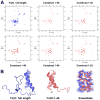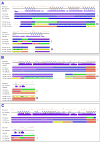Construct optimization for protein NMR structure analysis using amide hydrogen/deuterium exchange mass spectrometry
- PMID: 19306341
- PMCID: PMC2739808
- DOI: 10.1002/prot.22394
Construct optimization for protein NMR structure analysis using amide hydrogen/deuterium exchange mass spectrometry
Abstract
Disordered or unstructured regions of proteins, while often very important biologically, can pose significant challenges for resonance assignment and three-dimensional structure determination of the ordered regions of proteins by NMR methods. In this article, we demonstrate the application of (1)H/(2)H exchange mass spectrometry (DXMS) for the rapid identification of disordered segments of proteins and design of protein constructs that are more suitable for structural analysis by NMR. In this benchmark study, DXMS is applied to five NMR protein targets chosen from the Northeast Structural Genomics project. These data were then used to design optimized constructs for three partially disordered proteins. Truncated proteins obtained by deletion of disordered N- and C-terminal tails were evaluated using (1)H-(15)N HSQC and (1)H-(15)N heteronuclear NOE NMR experiments to assess their structural integrity. These constructs provide significantly improved NMR spectra, with minimal structural perturbations to the ordered regions of the protein structure. As a representative example, we compare the solution structures of the full length and DXMS-based truncated construct for a 77-residue partially disordered DUF896 family protein YnzC from Bacillus subtilis, where deletion of the disordered residues (ca. 40% of the protein) does not affect the native structure. In addition, we demonstrate that throughput of the DXMS process can be increased by analyzing mixtures of up to four proteins without reducing the sequence coverage for each protein. Our results demonstrate that DXMS can serve as a central component of a process for optimizing protein constructs for NMR structure determination.
Copyright 2009 Wiley-Liss, Inc.
Figures






References
-
- Cavanagh J, Fairbrother WJ, Palmer AG, III, Skelton NJ, Rance M. Protein NMR Spectroscopy: Principles and Practice. 2. New York: Elsevier Academic Press; 2007. p. 912.
-
- Kay LE. NMR studies of protein structure and dynamics. J Magn Reson. 2005;173:193–207. - PubMed
-
- Bax A, Grishaev A. Weak alignment NMR: A hawk-eyed view of biomolecular structure and dynamics. Curr Opin Struct Biol. 2005;15:563–570. - PubMed
-
- Liu J, Montelione GT, Rost B. Novel leverage of structural genomics. Nature Biotechnol. 2007;25:849–851. - PubMed
-
- Dyson HJ, Wright PE. Intrinsically unstructured proteins and their functions. Nature Rev. 2005;6:197–208. - PubMed
Publication types
MeSH terms
Substances
Grants and funding
LinkOut - more resources
Full Text Sources
Research Materials

